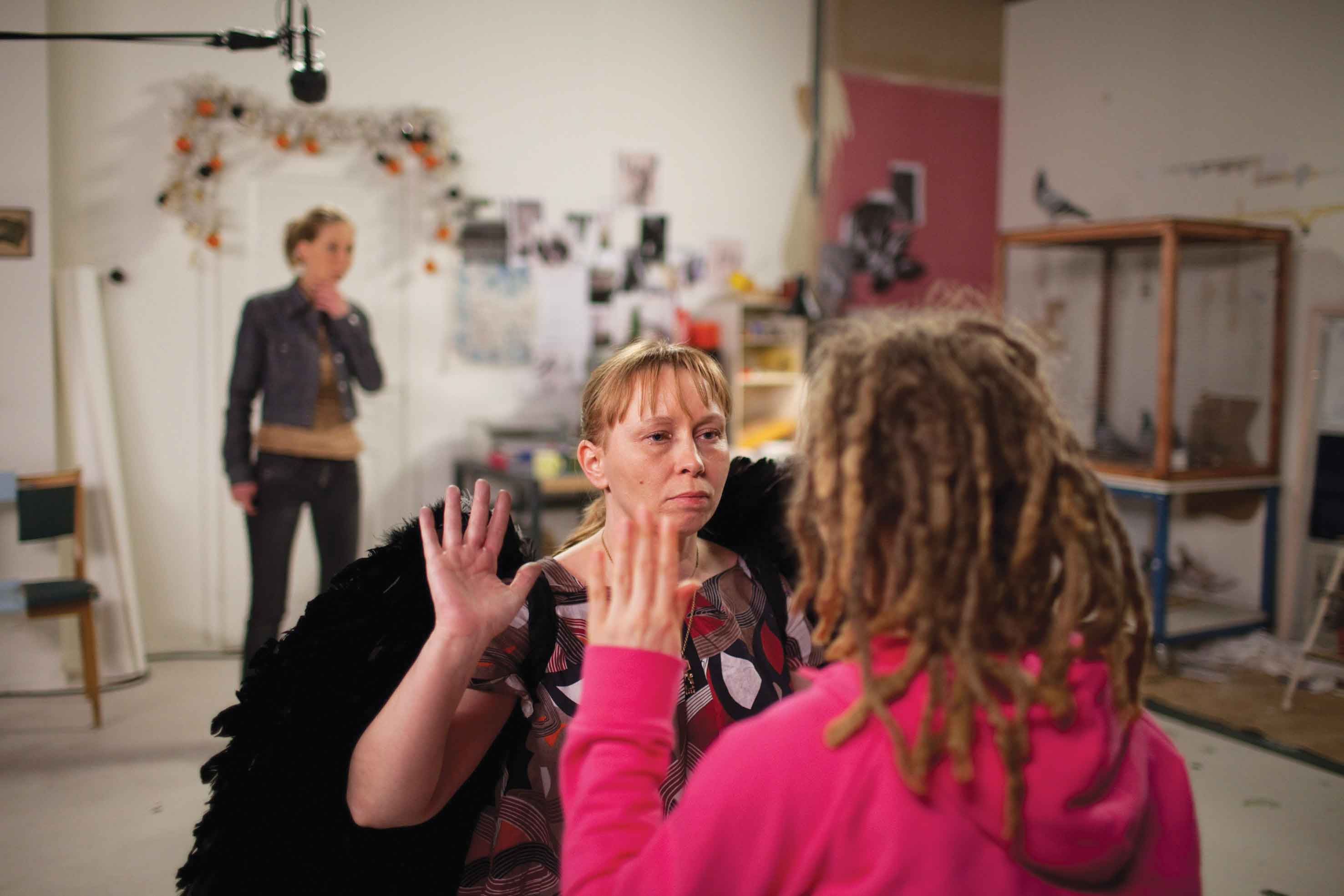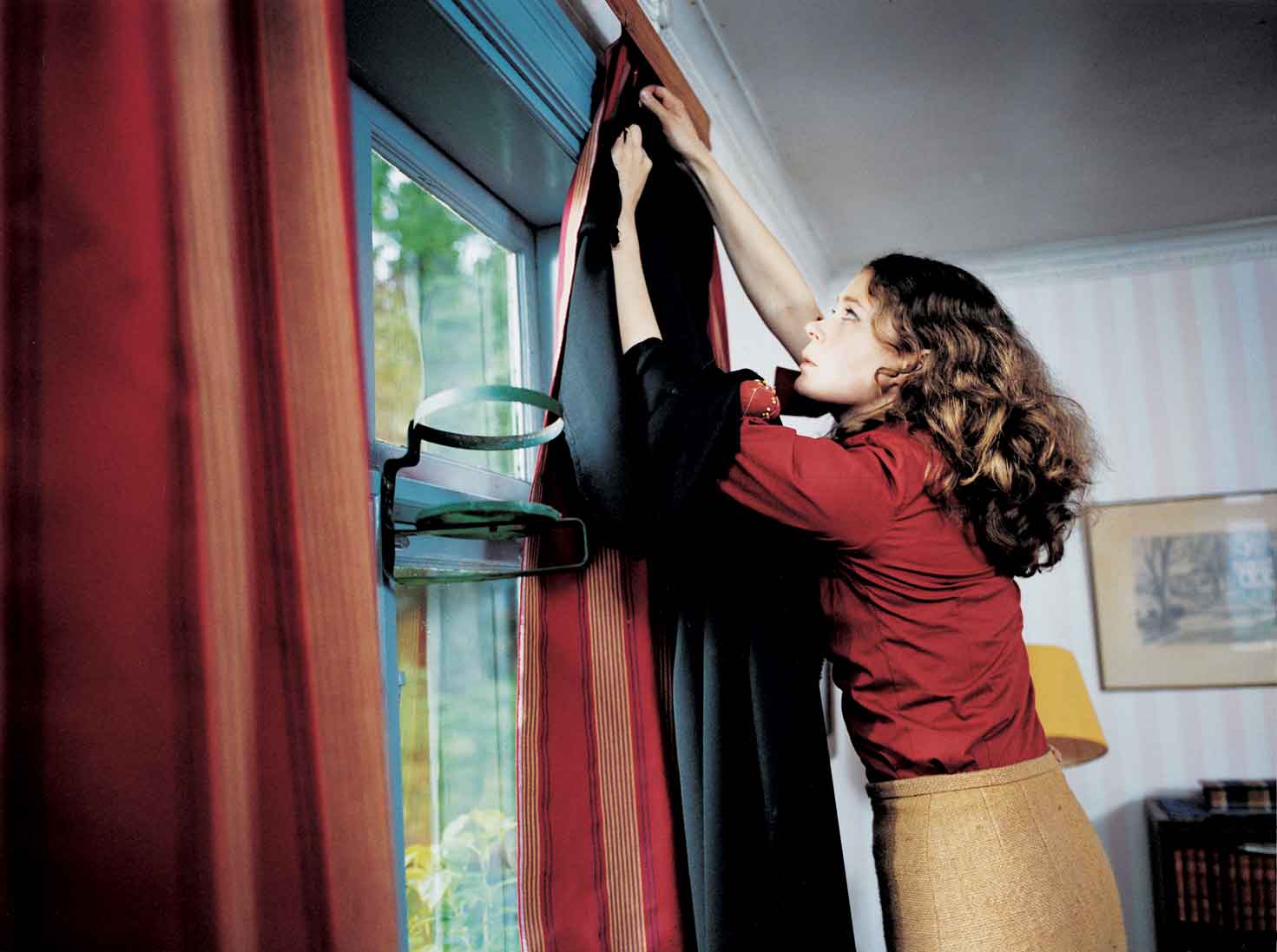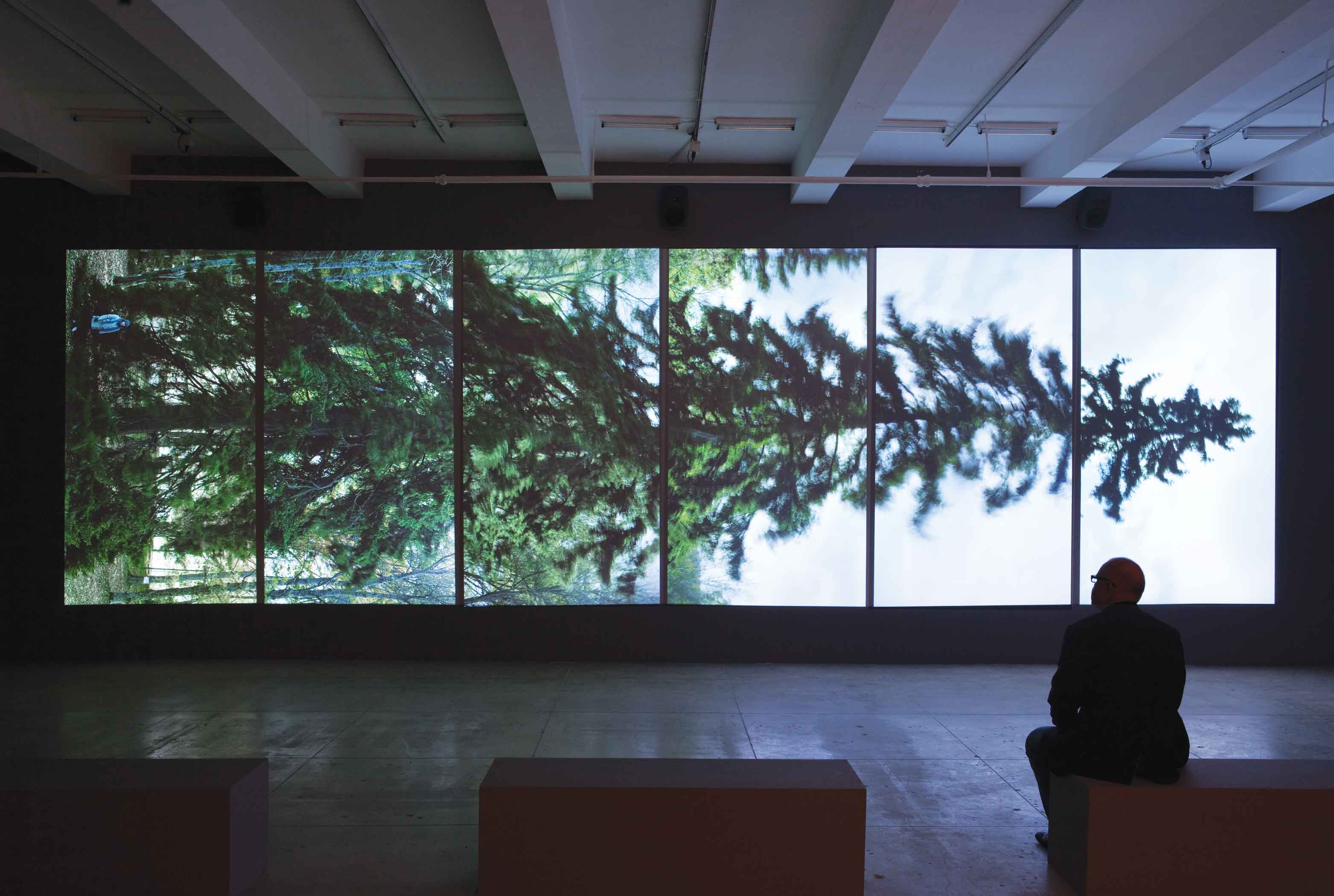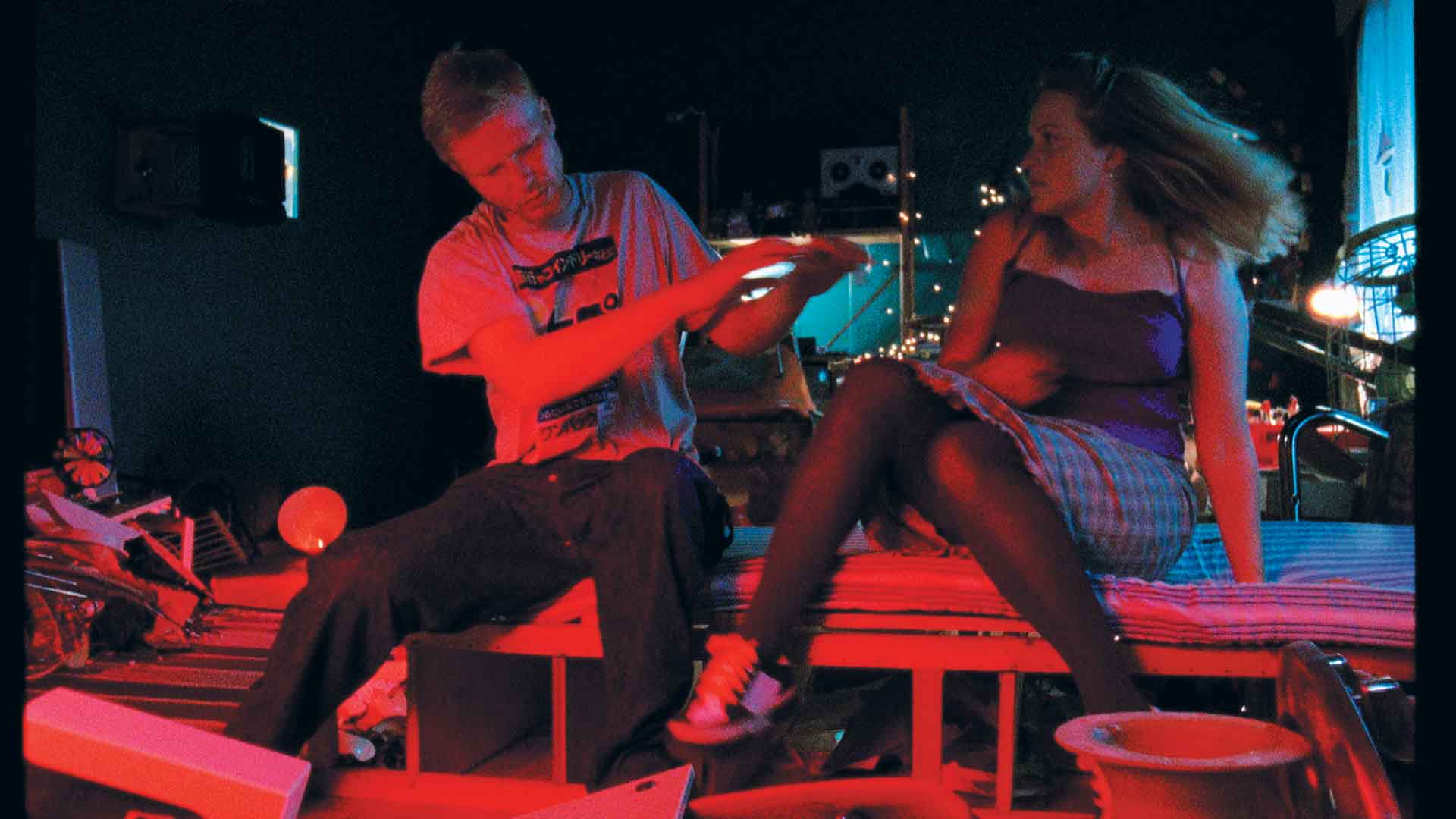« Face to Face
Breaking the Rules of Storytelling. A Conversation with Eija-Liisa Ahtila

Eija-Liisa Ahtila, Where is Where? (still), 2008, HD installation for 6 projections with sound. Photo: Marja-Leena Hukkanen. All images are courtesy of Marian Goodman Gallery, New York and Paris. © 2008 Crystal Eye – Kristallisilmä Oy.
For two decades, artist Eija-Liisa Ahtila (b.1959) has been a central figure in the vanguard movement of putting a new face on film installation art. Chrissie Iles, Curator at the Whitney Museum of American Art in New York, identifies the phenomenon as bringing the “black box of cinema into the white box of the museum.” Ms. Ahtila, who lives and works in Helsinki, Finland, created a media stir when she won the inaugural Vincent Award in 2000. In 2006, her multi-screen cinematic installation, The Wind, was exhibited at MoMA, and she was winner of the Artes Mundi Prize, in Cardiff, Wales, also in 2006. Her current exhibition “Parallel Worlds” is on view at the Moderna Museet in Stockholm, Sweden, through May 6, 2012. In this interview, we talked about new work and several of her most celebrated older works. Ms. Ahtila shared her motivations in breaking rules of storytelling and expanding rules of cinema in making poetic museum installations that appeal to both the gut and intellect and have a philosophical and social conscience.
By Stephen Knudsen
Stephen Knudsen - Your work has been categorized as ‘extended cinema‘ or ‘expanded cinema.‘ What does ‘extended cinema‘ mean in your work, and how do you define your approach to the cinematic in your museum installations?
Eija-Liisa Ahtila - I do not know what meaning those people who have used the concept have given to it in the context. In my installation works and films, I aim at approaching narratives by questioning the traditional rules of storytelling and ways of expressing with the means of the moving image.
Let’s take, for example, the character: There’s a set of rules for how to create a character and for the function of the protagonist. Can a tree be a protagonist or a space? How would that affect the rules of showing the story through action? In the multi-screen installations, I use editing to tell the story simultaneously on several screens and question the notions of central perspective and a certain way of giving information.

Marian Ilmestys - The Annunciation, 3-channel projected HD installation, 32 min 10 sec; 16:9; DD5.1. Photo: Jukka Rapo
S.K. - This questioning of the rules of traditional storytelling is certainly a type of expansion beyond traditional cinema. You do all this while retaining the very high production values of traditional ‘black box’ cinema, yet unlike traditional cinema you often bring qualities into the real space of the museum that go beyond the screens. Would you address that quality in your work?
E.A. - The visuality and expression in the installation has to do with the theme or subject matter of the work. Sometimes I prefer shooting with film, and in some cases, as with the making of part of The Annunciation, we used digital cameras. The installation space is usually painted with color chosen according to the colors and themes in the work. Sometimes, the walls are left plain white as in The Annunciation, where the floor was covered in carpet, Mary blue in color. Ultimately, though, the installation should look simple.
S.K. - Was there a critical encounter with a kindred spirit or mentor that helped you negotiate this very different way of working with film?
E.A. - No, no there wasn’t. That would have been great to have someone to talk to and discuss and test the ideas.
After I graduated as a painter, I became interested in video and moving image as an artistic medium. I also studied film, but I suppose my way of approaching film is one of an artist: I wanted to know what one can do with the medium, not to make a film for certain audience. Then again, since school I had been interested in literature, writing and stories.
S.K. - One of your most acclaimed film installations, Talo (The House), debuted at Documenta XI in 2002. You have shared that Talo‘s protagonist was inspired by actual interviews of women besieged by psychotic disorders. Would you tell us about that research, what drew you into this topic, and how it shaped Talo?
E.A. - I had actually worked earlier with a similar topic. For the opening exhibition of the Museum of Contemporary Art Kiasma in Helsinki 1998, I had made an installation, which was based on a true story of a man who had experienced psychosis. That installation looks quite different from the others; there were, for example, five men playing the same role of the main character on five monitors, two Gods on a screen, plus a live performer.
Three years later, I shot a film called Love is a Treasure. It has five episodes, of which House is the last one. For the works I interviewed several women who either had been ill with psychosis or still were. Based on those stories I wrote the script. I did not use anyone’s story as it had happened in reality, but rather I took some elements of them. For example, in the second-to-last episode (which is also an installation with three screens), I used the way of talking and the aggressive temper that one of the women had and then invented the events in the story myself. The House is not really anyone’s story. It’s more like an abstraction of the illness: a process of falling ill with psychosis.

The House, 2002, 14 min. DVD installation for 3 projections with sound. Photo: Marja-Leena Hukkanen.
S.K. - With subject matter such as a mental illness in The House, or death in Where is Where (2009), the narrative could so easily be colored with heavy melodrama (good like Bergman or bad like the kitsch of Hallmark), but you do not push it that far. Elisa in The House, for instance, never screams or cries. Even in the more charged piece, The Wind (2006), it seems that you kept the protagonist emotionally abstracted somewhat, just out of neutral in most scenes. Outside forces mostly move the protagonist, and literally so in the final scene where she is sucked up onto the wall. How did you come to those brave directorial decisions and what effect were you after?
E.A. - I think that every piece needs its own kind of acting and showing things with character. Since the topic was such, I felt it would be good to keep the acting very simple and kind of emotionless. In that way, for example, the emphasis in The Wind stayed in the woman’s monologue and her way of talking.
S.K. - Something extraordinary usually happens in your film installations and in completely unexpected ways. In The House there is a brief scene where the emotionally neutral protagonist, Elisa, leaves the ground and floats horizontally through spruce trees, tugging lightly on boughs and directing herself toward her house. There is no Hollywood film score, just bird song and the rustle of spruce needles. What does that kind of poetry briefly inserted into this piece do for the work in your eyes, and what inspired that scene?
E.A. - When one works with the moving image, there are always several options for how to tell about the events and the atmosphere. With the flying scene and the sounds of the forest, I aimed at telling how she kind of lost the gravity of things: a certain anchored meaning for things. I did not want there to be anything frightening or any angst in the scene, only to show another state of being.

The House, 2002, 14 min. DVD installation for 3 projections with sound. Photo: Marja-Leena Hukkanen.
S.K. - How do you overcome the temptation to over-use a good resource, like that flying scene, and thus in a sense kill it?
E.A. - Oh, I think I already have used flying too much in my works. I didn’t intend to use it after Where is Where? Never again. But then I started to plan a work of the Annunciation paintings. One of the characters of that story is an angel, so it was quite impossible to leave flying out. Instead, we then made it very physical, showed the rehearsing and how very human the actor was. That also became, then, one of the themes of the work: redefining the human through animal and divine.
S.K. - You are able to instill a poetic tone in much of the language in your work. Can you talk about your process of writing and how you usually get to a final script?
E.A. - Writing is great but very time consuming and slow. I cannot write too fast or too much during one day. The things drop on the page at their own pace, more or less. And the things find their connection with time. Each piece has its own pace and rhythm, also, in the way it comes together. If I write too fast, the text can get a shape that does not have what is needed, and then it is difficult to find that again.
It is a bit like in drawing: An empty paper holds a lot of possibilities and hidden forms that kind of show themselves if you stay in front of the paper and look. You have to proceed slowly to see the different parts that belong together, not to hurry, because then you will only get what you already know.
When I start writing a script, I don’t necessarily yet have a topic. If I do have one, I start researching and writing around the subject matter and make notes. If I just have some ideas, I start with making files of different things that I’ve thought of or I’ve run into: pieces of dialogue, a certain lighting situation, sounds I’ve heard or notes on scenes. Then later I connect the relevant ones together in the order that the work needs. Then I usually use a traditional scriptwriting format to some extent to make it communicable to the crew and other people reading it.
The amount of rewriting depends on the work and its aims. Sometimes when things are more explored with the performers, the script only stands as a support structure or guide on the side.
S.K. - I recently saw your 2011, six panel installation, The Horizontal, at the Marian Goodman Gallery in New York. You filmed a giant spruce in six sections on a very windy day and projected it so that the tree was horizontal on a 30-foot stretch of wall. Since the filming was asynchronous, and the wind movements did not match panel-to-panel, a mesmerizing complexity was created. Horizontal is an installation that I would enjoy walking by every day. It is surprisingly minimal coming from you and yet rich in its relationship to other work. How do you think of this piece beyond the pure poetry inherent in it?
E.A. - I’m really happy to hear your comment that you would enjoy walking by it every day! Actually years ago I thought of making a proposition for the Nokia headquarters lobby of a bit similar piece, and I then thought that a moving spruce with the sound surrounding it would be something that people would not get bored with.
I got an idea for The Horizontal when I was making a drawing series called Anthropomorphic Exercises on Film last summer, and the idea for that emerged during the shooting of the beginning scenes for The Annunciation in a nature forest park in Southern Finland. The intention was to shoot first a few landscapes and then some of those huge trees that grow there. But soon it became obvious that we could not shoot a big tree with a film camera. The reason for that is obvious: Due to the aspect ratio of the film frame, one cannot capture the size and height of the tree. One only gets part of it. And if one uses a wide-angle lens, the tree appears distorted. If one walks further away from the tree, the result will be a landscape, not a portrait of a tree. This led me to think about the relationship of the mechanics of film and the central role of the technical devices and equipment, which have been created for the extension of our perception.
Then, during last October, we planned and shot a tall spruce tree near that nature reserve. It was a long process, finally during which it became obvious that the more we worked on getting a ‘right’ kind of picture or portrait of the spruce, the more we actually were distancing ourselves from the tree itself and focusing on the human perception and presenting the technical means to capture our surroundings.

Horizontal, 2011, 6 min. 6-channel projected installation. Screening format: synchronized HD files.(Original format: 5K Red raw), 16:9/1:1,78. Dolby Digital 5.1 No dialoque. Photo: John Berens.
S.K. - The Horizontal ran concurrently with The Annunciation, which was in an adjacent gallery space. In a three-panel installation, your film takes hold of central motifs of Christian iconography based on the Gospel of Luke (1:26-38). To take on subject matter that has been so woven into the fabric of a large segment of humanity and Western art seems to me a great challenge. Is that part of what drew you into this work-to take something so aestheticized and to use it to express something fresh, by bringing into focus peripheral ideas concerning human and animal perception?
E.A. - It is a long story, but I try to keep it short. I wanted to explore the image and the event, which has been so central in Western cultural history in many ways. I wondered how it would work today and what we would recognize to be a miracle. I did not want to write a certain script for actors where the answers would stand and then they would have been played accordingly. Instead, I worked with a group of non-professionals whose lives had not taken the ‘straight path of virtue,’ so to say. The making of the work was a process that brought up many things. In the beginning, the narrator talks about perception: how we see things and how with perspective things become categorized and get a certain order. This is because, during the Renaissance when there was a boom of Annunciation painting, the central perspective made its way to painting. So our perception and way of seeing was kind of formed in those paintings. It is really interesting, but unfortunately I’m not an expert on art history.
One other matter was also taken in the work; in addition to the human actors, there were animals performing: the pigeons, the donkeys and a trained raven. They brought their own worlds into the piece, and their presence, together with the human actors, reconstructed the sacred and redefined what is human.
For me, the piece is important. That’s because it kind of stays in the scenes and in the actors. I mean that the actual reconstruction scene is not in any way central or the climax of the work. But instead the works show the humans and animals: the living beings in their worlds. The film version will not be a hit in short film festivals, I’m afraid. The structure of the piece is completely against what is usually regarded as a rewarding short film experience.
S.K. - Leading Finnish actress Kati Outinen was the main protagonist in the six-panel film installation Where is Where? (2009), arguably one of your most complex pieces. She plays a modern-day European poet who is invoked into negotiating with the character of Death. The concern is the murder of a French boy by his two Algerian playmates, an actual mid-20th-century episode that occurred during the Algerian war for independence under French colonial rule. The piece merges actual French newsreels, underplayed reenactments, and the time and space of the contemporary poet. Her encounters with the figure of death and a female priest weave in as well. The question must inevitably come up: Why this story? What connection does this poet have to a geographically and chronologically distant history that could easily be completely left out of mind in one‘s existence?
E.A. - Where is Where? is a work about a historical event and how it affects our lives today and how it could be brought into the present day so that we could understand it. It aims at raising questions like how do we see our history and how do we see the world and our place in it? It aims at asking what is of our concern in the present world situation, to which things should we react and how could we share our global concerns? For this, it uses a real event that took place in Algeria during the independence war. The two times, present day and the end of the ’50s, as well as the two places, Algeria and Finland, are mixed in the story with editing, thus asking what takes place in our backyard and what far away.
By form, the work is a six-screen installation with a four-screen space in the middle. You cannot follow all of the screen simultaneously; inevitably one is behind you. The events are taking place around the viewer, and s/he needs to choose what to look at. The material is edited so that it forms a coherent space both inside the screen as well as across the viewing space. The events run from screen to screen, and the actors talk to each other on screen across the space, in this way kind of involving the viewer in the situation.
S.K. - Had this work been described to me before I had seen it, I think I would have been skeptical. Just the one issue of merging of black-and-white newsreel footage with reenactments always seems forced and not quite right. But I did not have that negative reaction in seeing Where is Where? What were your thoughts on getting all that heterogeneous material to merge into proper gestalt?
E.A. - The use of archive footage had to do with the overall approach toward the issue. I could not, nor did I want to, make a period piece. I had to find a way to represent the event that took place in another time and a culture different from ours. I aimed at distancing the event with the visual look, the poetic monologues and the use of a theatre stage as well as the archive material of the war. I guess I tried to make an art piece out of a real event that took place 60 years ago in Europe and Algeria.
S.K. - Letting some action take place on a Brechtian stage may seem counterintuitive to some, but it works. What are your thoughts on allowing some stagey quality in the reenactment scenes?
E.A. - One function of a stage is to show something taken from its original surroundings and underline the event or thing. I aimed at doing that, for example, in the final scene were the boys are questioned about the killing.

Where is Where?, 2008, HD installation for 6 projections with sound. Photo: Marja-Leena Hukkanen. All images are courtesy of Marian Goodman Gallery, New York and Paris. © 2008 Crystal Eye – Kristallisilmä Oy.
S.K. - In Where is Where? you use some gorgeous jump cuts: the spinning dancers splicing to the spinning knife and the bombs dropping splicing to the bathing poet at the moment she plunges into the lake. Editing must be extraordinarily complicated with the juggling of six screens. What is your editing philosophy in pieces like this?
E.A. - We edited the four screens in the middle of the installation simultaneously. To be able to create a flow of events on four screens simultaneously, one has to plan and draw everything in advance. You can imagine that if there are eight actors at the same time, and you have to get the directions of their movements and their gazes right for four screens plus timing correct, it is a lot of work. The editing is done according to the plans, but a lot, of course, happens during the process. You learn what can be juxtaposed and how to guide the viewer’s attention, for example.
S.K. - Your films are often shot on Super 16 mm or 35 mm and then transferred to digital format. Do you feel you still get an extra formal quality by doing this, even though shooting digitally has reached a standard where directors like George Lucas are willing to use it for major motion pictures?
E.A. - When we were shooting The Annunciation, we used digital cameras for all else except the reconstruction scene were the angel is flying inside to tell the news to Mary. That was shot with 35 mm film. With this I wanted to achieve a visual effect to that scene. In that way, the colors look richer and the volume is different. Basically, I think digital material is fine and cheaper and easier.
S.K. - Are you working on anything new at the moment that you are ready to talk about?
E.A. - I have several projects in mind, but I have not really started to work on anything seriously yet. I will have an opening in Moderna Museet in Stockholm soon-after that then (I will begin new work).
* This conversation was held in February 2012.



































